Abstract
Six week old BDF1 female mice were exposed to cadmium chloride in the drinking water at concentrations ranging from 0 to 50 micrograms/mL cadmium for three weeks. The humoral immune response against sheep red blood cells which is T-lymphocyte and macrophage dependent, was suppressed in a dose dependent fashion with the maximum suppression of 28.2% observed in the highest exposure group (P less than 0.0001). Mitogen studies demonstrated that cadmium was a weak mitogen, producing a dose-dependent enhancement of blastogenesis (P = 0.026). T-lymphocyte responses which were induced by concanavalin A were not affected by cadmium exposure (P = 0.284). A dose-dependent enhancement of the B-lymphocyte activity was produced in the presence of cadmium when the lymphocytes were induced with Escherichia coli, lipopolysaccharide, a B-lymphocyte mitogen (P = 0.007). These results suggest that the immunosuppressive effects of cadmium associated with the humoral immune response are not due to an impairment of lymphocyte proliferation, an intermediate step involved in the generation of an immune response. The immunosuppressive effects were produced at relatively low cadmium exposures as indicated by the renal cadmium concentrations suggesting that the immune systems is very vulnerable to the toxic effects of cadmium.
Full text
PDF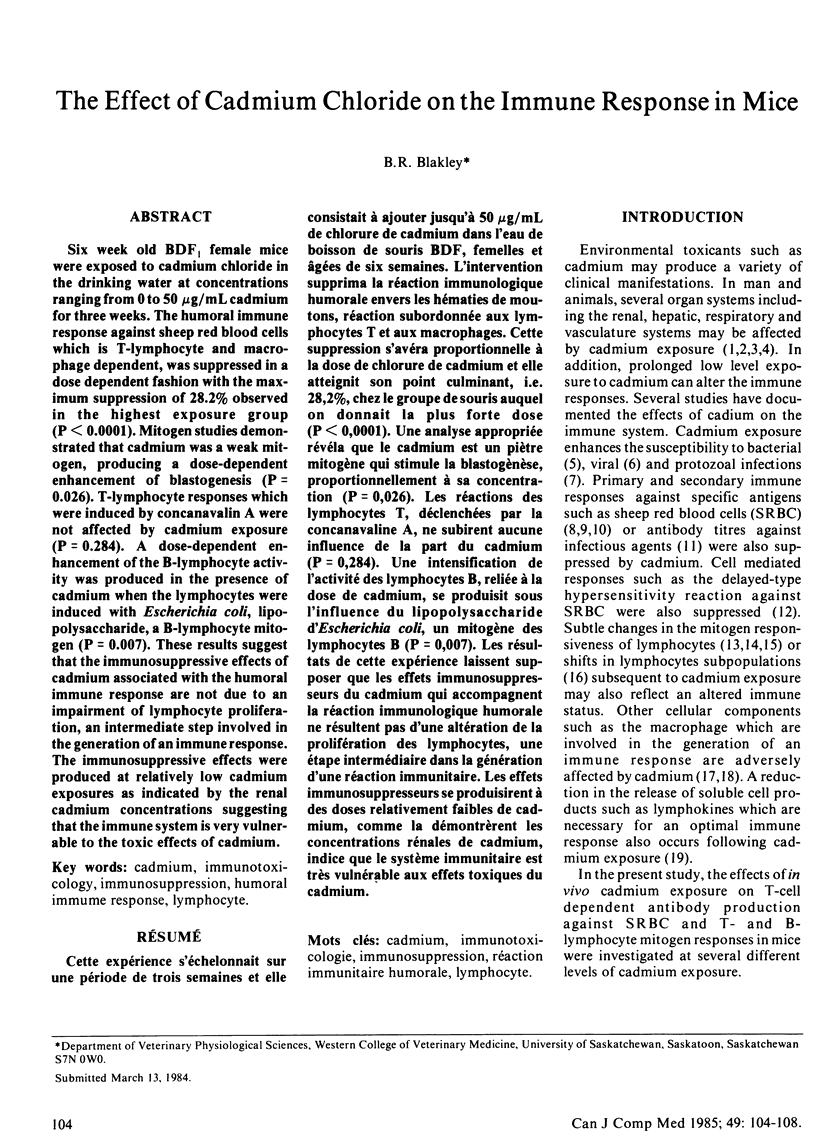
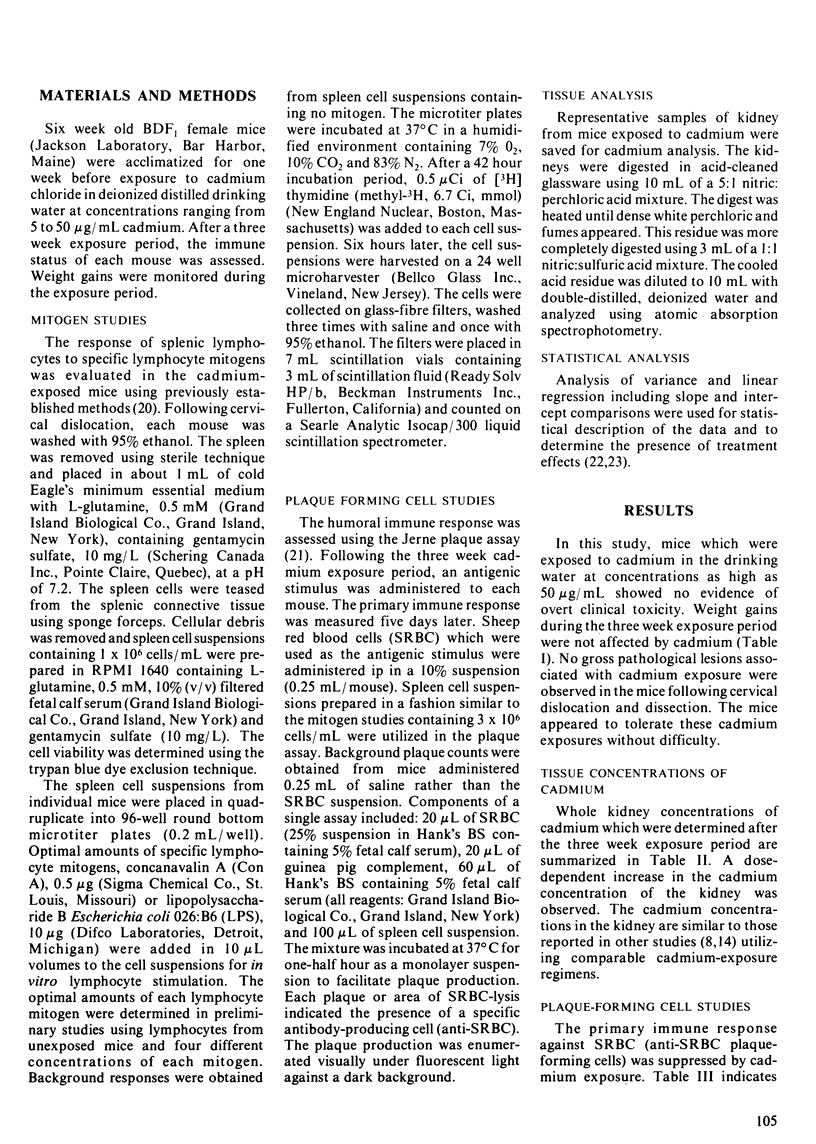
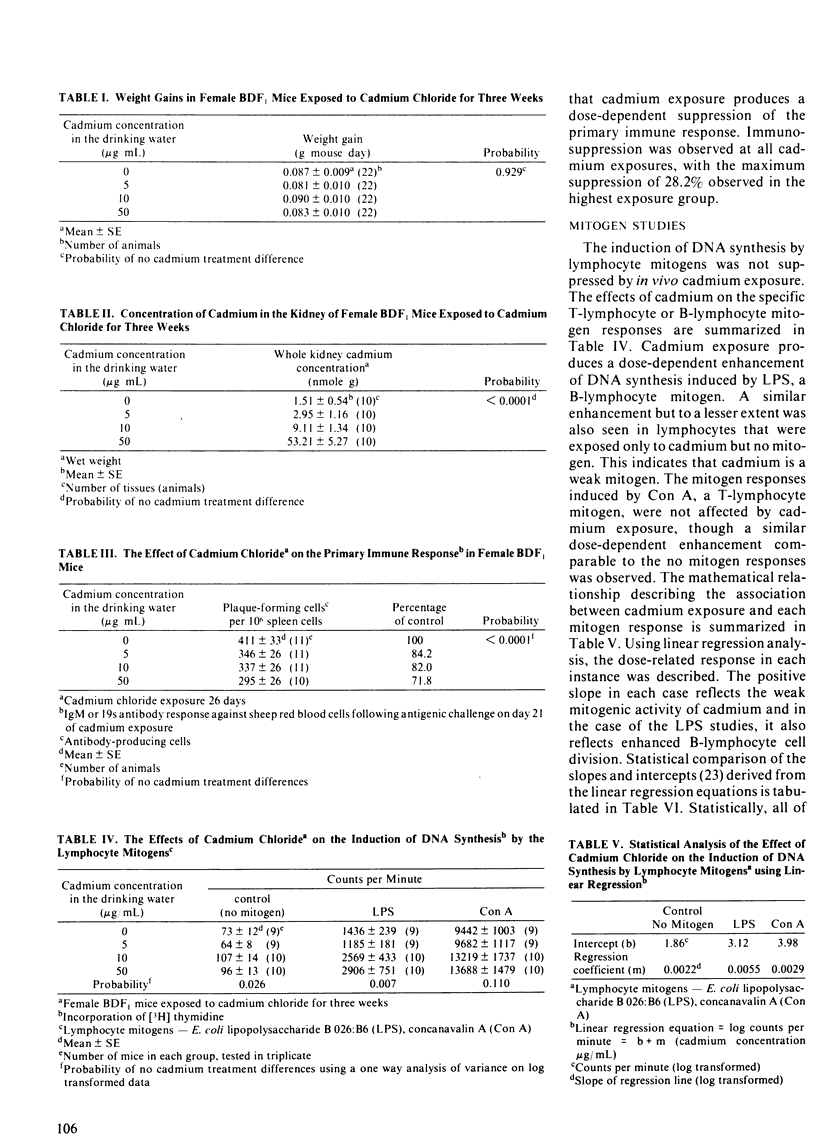
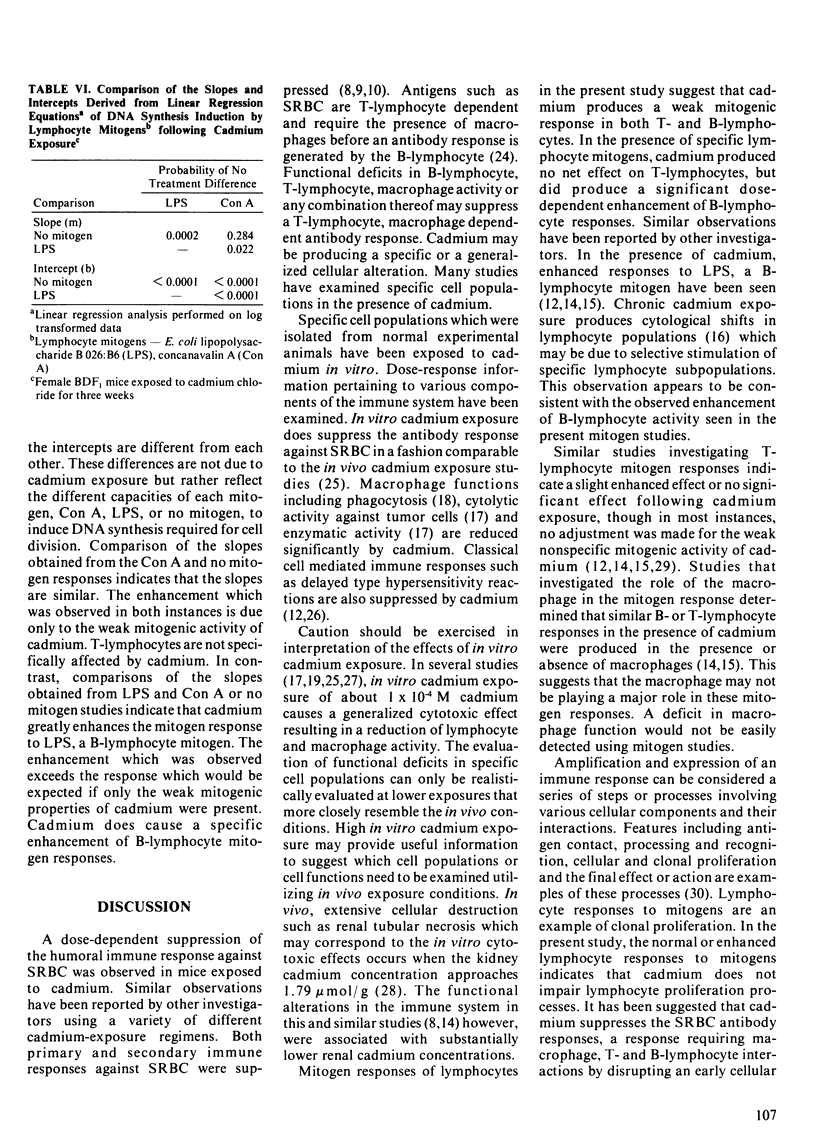
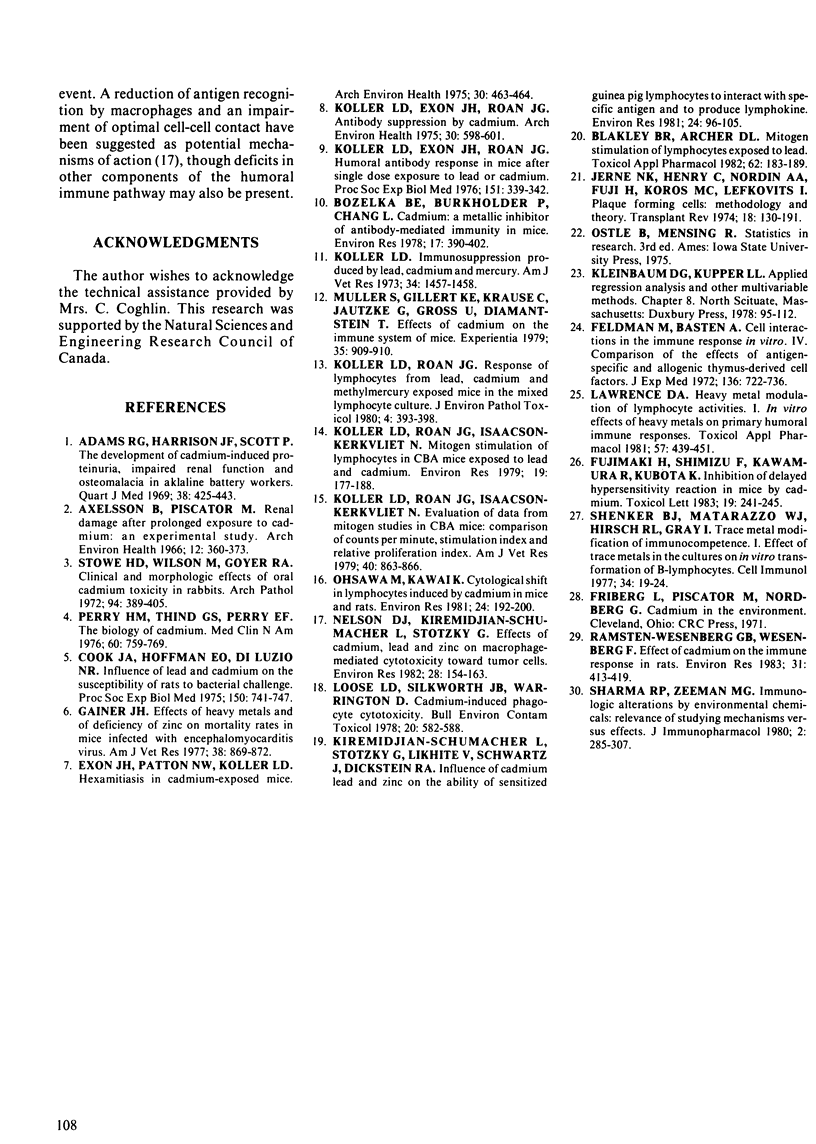
Selected References
These references are in PubMed. This may not be the complete list of references from this article.
- Adams R. G., Harrison J. F., Scott P. The development of cadmium-induced proteinuria, impaired renal function, and osteomalacia in alkaline battery workers. Q J Med. 1969 Oct;38(152):425–443. [PubMed] [Google Scholar]
- Axelsson B., Piscator M. Renal damage after prolonged exposure to cadmium. An experimental study. Arch Environ Health. 1966 Mar;12(3):360–373. doi: 10.1080/00039896.1966.10664382. [DOI] [PubMed] [Google Scholar]
- Blakley B. R., Archer D. L. Mitogen stimulation of lymphocytes exposed to lead. Toxicol Appl Pharmacol. 1982 Feb;62(2):183–189. doi: 10.1016/0041-008x(82)90116-8. [DOI] [PubMed] [Google Scholar]
- Bozelka B. E., Burkholder P. M., Chang L. W. Cadmium, a metallic inhibitor of antibody-mediated immunity in mice. Environ Res. 1978 Dec;17(3):390–402. doi: 10.1016/0013-9351(78)90042-7. [DOI] [PubMed] [Google Scholar]
- Cook J. A., Hoffmann E. O., Luzio NR D. i. Influence of lead and cadmium on the susceptibility of rats to bacterial challenge. Proc Soc Exp Biol Med. 1975 Dec;150(3):741–747. doi: 10.3181/00379727-150-39117. [DOI] [PubMed] [Google Scholar]
- Exon J. H., Patton N. M., Koller L. D. Hexamitiasis in cadmium-exposed mice. Arch Environ Health. 1975 Sep;30(9):463–464. doi: 10.1080/00039896.1975.10666751. [DOI] [PubMed] [Google Scholar]
- Feldmann M., Basten A. Cell interactions in the immune response in vitro. IV. Comparison of the effects of antigen-specific and allogeneic thymus-derived cell factors. J Exp Med. 1972 Oct 1;136(4):722–736. doi: 10.1084/jem.136.4.722. [DOI] [PMC free article] [PubMed] [Google Scholar]
- Fujimaki H., Shimizu F., Kawamura R., Kubota K. Inhibition of delayed hypersensitivity reaction in mice by cadmium. Toxicol Lett. 1983 Dec;19(3):241–245. doi: 10.1016/0378-4274(83)90125-x. [DOI] [PubMed] [Google Scholar]
- Gainer J. H. Effects of heavy metals and of deficiency of zinc on mortality rates in mice infected with encephalomyocarditis virus. Am J Vet Res. 1977 Jun;38(6):869–872. [PubMed] [Google Scholar]
- Jerne N. K., Henry C., Nordin A. A., Fuji H., Koros A. M., Lefkovits I. Plaque forming cells: methodology and theory. Transplant Rev. 1974;18:130–191. doi: 10.1111/j.1600-065x.1974.tb01588.x. [DOI] [PubMed] [Google Scholar]
- Kiremidjian-Schumacher L., Stotzky G., Likhite V., Schwartz J., Dickstein R. A. Influence of cadmium, lead, and zinc on the ability of sensitized guinea pig lymphocytes to interact with specific antigen and to produce lymphokine. Environ Res. 1981 Feb;24(1):96–105. doi: 10.1016/0013-9351(81)90136-5. [DOI] [PubMed] [Google Scholar]
- Koller L. D., Exon J. H., Roan J. G. Antibody suppression by cadmium. Arch Environ Health. 1975 Dec;30(12):598–601. doi: 10.1080/00039896.1975.10666787. [DOI] [PubMed] [Google Scholar]
- Koller L. D., Exon J. H., Roan J. G. Humoral antibody response in mice after single dose exposure to lead or cadmium. Proc Soc Exp Biol Med. 1976 Feb;151(2):339–342. doi: 10.3181/00379727-151-39205. [DOI] [PubMed] [Google Scholar]
- Koller L. D. Immunosuppression produced by lead, cadmium, and mercury. Am J Vet Res. 1973 Nov;34(11):1457–1458. [PubMed] [Google Scholar]
- Koller L. D., Roan J. G., Kerkvliet N. I. Evaluation of data from mitogen studies in CBA mice: comparison of counts per minute, stimulation index and relative proliferation index. Am J Vet Res. 1979 Jun;40(6):863–865. [PubMed] [Google Scholar]
- Koller L. D., Roan J. G., Kerkvliet N. I. Mitogen stimulation of lymphocytes in CBA mice exposed to lead and cadmium. Environ Res. 1979 Jun;19(1):177–188. doi: 10.1016/0013-9351(79)90045-8. [DOI] [PubMed] [Google Scholar]
- Koller L. D., Roan J. G. Response of lymphocytes from lead, cadmium, and methylmercury exposed mice in the mixed lymphocyte culture. J Environ Pathol Toxicol. 1980 Aug;4(1):393–398. [PubMed] [Google Scholar]
- Lawrence D. A. Heavy metal modulation of lymphocyte activities. 1. In vitro effects of heavy metals on primary humoral immune responses. Toxicol Appl Pharmacol. 1981 Mar 15;57(3):439–451. doi: 10.1016/0041-008x(81)90241-6. [DOI] [PubMed] [Google Scholar]
- Loose L. D., Silkworth J. B., Warrington D. Cadmium-induced phagocyte cytotoxicity. Bull Environ Contam Toxicol. 1978 Nov;20(5):582–588. doi: 10.1007/BF01683568. [DOI] [PubMed] [Google Scholar]
- Müller S., Gillert K. E., Krause C., Jautzke G., Gross U., Diamantstein T. Effects of cadmium on the immune system of mice. Experientia. 1979 Jul 15;35(7):909–910. doi: 10.1007/BF01955143. [DOI] [PubMed] [Google Scholar]
- Nelson D. J., Kiremidjian-Schumacher L., Stotzky G. Effects of cadmium, lead, and zinc on macrophage-mediated cytotoxicity toward tumor cells. Environ Res. 1982 Jun;28(1):154–163. doi: 10.1016/0013-9351(82)90164-5. [DOI] [PubMed] [Google Scholar]
- Ohsawa M., Kawai K. Cytological shift in lymphocytes induced by cadmium in mice and rats. Environ Res. 1981 Feb;24(1):192–200. doi: 10.1016/0013-9351(81)90144-4. [DOI] [PubMed] [Google Scholar]
- Perry H. M., Jr, Thind G. S., Perry E. F. The biology of cadmium. Med Clin North Am. 1976 Jul;60(4):759–769. doi: 10.1016/s0025-7125(16)31859-4. [DOI] [PubMed] [Google Scholar]
- Sharma R. P., Zeeman M. G. Immunologic alterations by environmental chemicals: relevance of studying mechanisms versus effects. J Immunopharmacol. 1980;2(3):285–307. doi: 10.3109/08923978009046463. [DOI] [PubMed] [Google Scholar]
- Shenker B. J., Matarazzo W. J., Hirsch R. L., Gray I. Trace metal modification of immunocompetence. I. Effect of trace metals in the cultures on in vitro transformation of B lymphocytes. Cell Immunol. 1977 Nov;34(1):19–24. doi: 10.1016/0008-8749(77)90225-8. [DOI] [PubMed] [Google Scholar]
- Stowe H. D., Wilson M., Goyer R. A. Clinical and morphologic effects of oral cadmium toxicity in rabbits. Arch Pathol. 1972 Nov;94(5):389–405. [PubMed] [Google Scholar]


